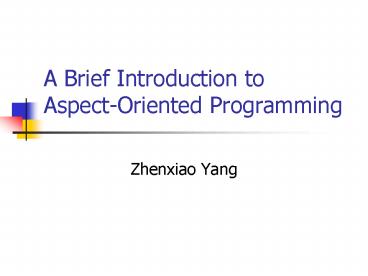A Brief Introduction to Aspect-Oriented Programming - PowerPoint PPT Presentation
1 / 21
Title:
A Brief Introduction to Aspect-Oriented Programming
Description:
An explicit sequence of steps to follow to produce a result. Examples: Basic, ... Ada, Object Pascal, Objective C, DRAGOON, BETA, Emerald, POOL, Eiffel, Self, ... – PowerPoint PPT presentation
Number of Views:24
Avg rating:3.0/5.0
Title: A Brief Introduction to Aspect-Oriented Programming
1
A Brief Introduction to Aspect-Oriented
Programming
- Zhenxiao Yang
2
Historical View Of Languages
- Procedural language
- Functional language
- Object-Oriented language
3
Procedural Language
- Also named imperative language
- Describe
- An explicit sequence of steps to follow to
produce a result - Examples Basic, Pascal, C
4
Functional Language
- Also named declarative language
- Describe
- relationships between variables in terms of
functions or inference rules. - Examples
- Prolog Logical programming language
- Haskell Functional language
5
Object-Oriented Programming
- Describe
- A set of objects
- And communications among them to produce a result
- Basic features
- Encapsulation
- Inheritance
- Polymorphism
6
OOP (contd)
- Example languages
- First OOP language SIMULA-67 (1970)
- Smalltalk, C, Java
- Many other
- Ada, Object Pascal, Objective C, DRAGOON, BETA,
Emerald, POOL, Eiffel, Self, Oblog, ESP, POLKA,
Loops, Perl, VB - Are OOP languages procedural?
7
We Need More
- Major advantage of OOP
- Modular structure
- Potential problems with OOP
- Issues distributed in different modules result in
tangled code. - Example logging
8
We Need More (contd)
- We need a solution to this tangled-code problem
- One approach is Aspect-Oriented Programming
9
Basic Concepts in AOP
- cross-cutting
- aspect
- join point
- pointcut
- advice
- introduction
10
AspectJ by Example
11
AspectJ by Example (contd)
- Define pointcuts
- Define advice
- Introduction
12
Pointcuts
- pointcut
- pointcut move()
- call(void FigureElement.setXY(int,int))
- call(void Point.setX(int))
- call(void Point.setY(int))
- call(void Line.setP1(Point))
- call(void Line.setP2(Point))
- pointcut produce call(void Figure.make(..))
- pointcut setXY(FigureElement fe, int x, int y)
- call(void fe.setXY(x, y))
13
Advice
- Advice
- after() move()
- System.out.println(A figure element
moved. ) - after (FigureElement fe, int x, int
y)setXY(fe,x,y) - System.out.println(fe moved to
x, , y)
14
Aspects
- aspect FigureLog
- pointcut setXY(FigureElement fe, int x, int
y) - calls(void fe.setXY(x, y))
- after(FigureElement fe, int x, int y)
setXY(fe, x, y) - System.out.println(fe " moved to ("
- x ", " y
").")
15
Introduction
- Introduction
- Add members to a set of Classes
- Change inheritance structure of classes
16
Introduction (contd)
- aspect PointObserving
- private Vector Point.observers new Vector()
- public static void addObserver(Point p, Screen
s) - p.observers.add(s)
- public static void removeObserver(Point p,
Screen s) - p.observers.remove(s)
- ....
17
Introduction (contd)
- public class A1
- function foo()
- public class A2
- function foo()super.foo()
- public class A3
- function foo()super.foo()
- aspect A1A2A3
- declare parents A2 extends A1
- declare parents A3 extends A2
18
Introduction (contd)
- public class A1
- function foo()
- public class A2
- function foo()super.foo()
- public class A3
- function foo()super.foo()
- aspect A1A3A2
- declare parents A3 extends A1
- declare parents A2 extends A3
19
What Can AspectJ Do for Us
- Developing
- Tracing, Logging, and Profiling
- Pre- and Post-Conditions
- Contract Enforcement
- Production
- Change Monitoring
- Synchronization
- Context Passing
- Providing Consistent Behavior
- Introduction
20
Conclusion and Open Issues
- AOP vs OOP
- AOP is not substitute for OOP
- AOP makes OOP more powerful
- AOP also has runtime overhead
- We should use OOP as much as possible
- Reuse of aspects
- Tool support
21
Related Work
- AspectJ
- Reflection and meta-object protocols
- Meta-object provides mechanism to control over
base-objects - Subject-Oriented Programming
- Intentional Programming































